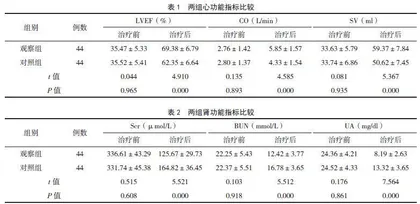综合对症联合连续性静脉-静脉血液滤过+血液灌流治疗急性胰腺炎的效果观察
作者: 王义大

【摘要】 目的 探讨综合对症联合连续性静脉-静脉血液滤过(CVVH)+血液灌流(HP)治疗对急性胰腺炎(AP)患者心肾功能及血清淀粉酶(AMY)、降钙素原(PCT)水平的影响。方法 选取2020年4月- 2022年4月医院治疗的88例AP患者作为研究对象,根据组间性别、年龄、发病原因等基线资料均衡可比的原则分为观察组44例和对照组44例。观察组给予综合对症联合CVVH+HP治疗,对照组仅给予综合对症治疗,比较两组治疗前后心功能指标[左心室射血分数(LVEF)、心排出量(CO)与每搏输出量(SV)]、肾功能指标[肌酐(Scr)、尿素氮(BUN)、尿酸(UA)]、血清AMY和PCT水平,以及急性生理学与慢性健康状况评分系统Ⅱ(APACHE Ⅱ)评分和生存率。结果 治疗前,两组心功能、肾功能、AMY、PCT水平和APACHE Ⅱ评分比较,差异均无统计学意义(P>0.05);治疗后,观察组LVEF、CO及SV心功能指标均高于对照组,Scr、BUN及UA肾功能指标低于对照组,差异有统计学意义(P<0.05)。观察组治疗后血清AMY、PCT水平均比对照组低,差异有统计学意义(P<0.05)。观察组治疗后APACHE Ⅱ评分比对照组低,差异有统计学意义(P<0.05)。观察组入院治疗7d内生存率为97.73%,高于对照组的84.09%,但差异无统计学意义(P>0.05)。结论 综合对症联合CVVH+HP治疗AP患者临床效果显著,能有效改善心肾功能,减轻炎症反应,控制病情发展,提升患者预后。
【关键词】 综合对症治疗;连续性静脉-静脉血液滤过;血液灌流;急性胰腺炎;心肾功能
中图分类号 R576 文献标识码 A 文章编号 1671-0223(2023)09--05
Observation on the effect of comprehensive symptomatic combination with continuous veno-venous hemofiltration and hemoperfusion in the treatment of acute pancreatitis Wang Yida. Second Department of General Surgery, Linyi Cancer Hospital, Linyi 276000, China
【Abstract】 Objective To explore the effect of comprehensive symptomatic treatment combined with continuous veno-venous hemofiltration (CVVH) and hemoperfusion (HP) on cardiac and renal function and serum amylase (AMY) and procalcitonin (PCT) levels in patients with acute pancreatitis (AP). Methods Eighty-eight patients with AP who were treated in the hospital from April 2020 to April 2022 were selected as the study subjects. According to the principle of balanced and comparable baseline data such as sex, age, and cause of disease among the groups, 44 patients were divided into the observation group and 44 patients in the control group. The observation group was given comprehensive symptomatic treatment combined with CVVH+HP, while the control group was only given comprehensive symptomatic treatment. The cardiac function indexes [left ventricular ejection fraction (LVEF), cardiac output (CO) and stroke volume (SV)], renal function indexes [serum creatinine (Scr), blood urea nitrogen (BUN), uric acid (UA)], serum levels of AMY, PCT, and the acute physiology and acute physiology and chronic health evaluation Ⅱ(APACHE Ⅱ) score and survival rate were compared before and after treatment. Results Before treatment, there was no significant difference between the two groups in cardiac function, renal function, AMY, PCT level and APACHE Ⅱ score (P>0.05). After treatment, the indexes of LVEF, CO and SV cardiac function in the observation group were higher than those in the control group, while the indexes of Scr, BUN and UA renal function in the observation group were lower than those in the control group, with a statistically significant difference (P<0.05). After treatment, the levels of serum AMY and PCT in the observation group were lower than those in the control group, and the difference was statistically significant (P<0.05). After treatment, the APACHE Ⅱ score in the observation group was lower than that in the control group, and the difference was statistically significant (P<0.05). The survival rate of the observation group was 97.73% within 7 days after admission, higher than 84.09% in the control group, but the difference was not statistically significant (P>0.05).Conclusion The treatment of AP patients with symptomatic combination CVVH+HP has a significant clinical effect, which can effectively improve cardiac and renal function, reduce inflammatory reaction, control the development of disease, and improve the prognosis of patients.
【Key words】 Comprehensive symptomatic treatment; Continuous veno-venous hemofiltration; Hemoperfusion; Acute pancreatitis; Cardiac and renal function
急性胰腺炎(acute pancreatitis,AP)是消化科常见急腹症之一,具有发病率高、病情进展快、发病急等特点,在所有急腹症中AP发病率位于3~5位,且世界范围内AP发病率不断升高[1]。AP以腹胀腹痛、血尿淀粉酶升高等为主要症状,由于病情发展迅速,若未得到及时有效治疗,则可能引起消化道出血、多器官功能衰竭、继发性感染等严重不良事件,升高病死风险。因此,给予AP患者积极有效的治疗尤为重要。目前,AP尚无特效药治疗,临床多以生长抑制素、胰蛋白酶抑制剂、泮托拉唑等多种综合对症治疗方式改善患者整体生理功能,但临床疗效并不理想。连续性血液净化是清除体内炎性因子等多种毒素与代谢废物的有效治疗手段,连续性静脉-静脉血液滤过(continuous veno-venous hemofiltration,CVVH)和血液灌流(hemoperfusion,HP)均是连续性血液净化常用技术,近年来在重症胰腺炎、败血症、脓毒血症等危急重症患者治疗中被广泛应用[2-3]。本研究在综合对症治疗基础上联合CVVH+HP治疗,探讨治疗方式对患者心肾功能及血清淀粉酶(amylase,AMY)、降钙素原(procalcitonin,PCT)水平的影响,具体报告如下。
1 对象与方法
1.1 研究对象
选取2020年4月- 2022年4月医院治疗的88例AP患者作为研究对象,根据组间基线资料均衡可比的原则分为观察组44例和对照组44例。观察组男25例,女19例;发病原因:胆道疾病15例,高脂血症23例,暴饮暴食6例;年龄29~51岁,平均40.52±6.89岁;发病至入院时间1~6h,平均3.87±1.50h。对照组男27例,女17例;发病原因:胆道疾病14例,高脂血症25例,暴饮暴食5例;年龄28~49岁,平均40.12±6.62岁;发病至入院时间1~5h,平均3.53±1.47h。两组以上基线资料比较,差异无统计学意义(P>0.05)。本研究经医院医学伦理委员会审查批准。
(1)纳入标准:均符合《急性胰腺炎基层诊疗指南》中相关诊断标准[4],且经临床CT等检查证实;临床表现为明显腹胀、上腹疼痛、呕吐等症状;均为首次发病,且发病至入院时间<24h;急性生理学与慢性健康状况评分系统Ⅱ[5](acute physiology and chronic health Ⅱ,APACHE Ⅱ)≥8分;无CVVH、HP治疗禁忌证;临床相关资料均完整。
(2)排除标准:合并肝脏、心脏等重要器官功能障碍;合并感染性疾病、传染性疾病及免疫系统疾病;存在精神疾病、意识障碍;合并恶性肿瘤;妊娠、哺乳期女性。
1.2 治疗方法
1.2.1 对照组 给予综合对症治疗,例如禁饮禁食、吸氧、心电监护、胃肠减压、灌肠、抗生素抗感染、纠正电解质失衡、维持酸碱平衡、抑制胃酸(质子泵抑制剂)、镇痛(东莨菪碱肌注)、抑制胰酶分泌(生长抑素)等,同时,胰性脑病者可给予地西泮、维生素B1等对症治疗,出现腹腔积液者可进行腹腔穿刺引流,对于合并其他症状者可以给予正确的其他对症治疗。
1.2.2 观察组 在综合对症治疗基础上给予CVVH+HP治疗,具体如下。
(1)CVVH:首先经股静脉穿刺置入双腔中心静脉导管,建立血液通路,形成完整的体外循环装置,利用Aquarius AV600型床旁血滤机(美国Baxter百特公司),采用一次性聚巩膜装置过滤,150~200ml/min,置换液速度2000ml/h,超滤量由患者每日出入量决定,使用肝素钠注射液(成都市海通药业有限公司,国药准字:H51021209,1.25IU/支)进行抗凝,第一次给药1000~3000IU,然后按10~15U/(kg·h)持续输入。每次治疗20~24h,24h更换一次血滤器,隔天治疗1次,连续治疗3次以上,血液过滤期间严密观察患者病情。
(2)HP:利用HA300型一次性树脂血液灌流器(中国珠海丽珠公司)串联,血流速度150~200ml/min,灌流时间2h,隔天治疗1次,连续治疗3次以上。
1.3 观察指标
(1)心功能指标:利用彩色多普勒超声仪(美国GE公司,Viv-id7型)检测左心室射血分数(left ventricular ejection fraction,LVEF)、心排出量(cardiac output,CO)与每搏输出量(stroke volume,SV)。
(2)肾功能指标和血清AMY、PCT水平:抽取两组治疗前后空腹静脉血3ml,置入离心机,离心半径10cm,速度3000r/min,时间10min,获得清液后保存于-20℃冰箱待测。采用美国BECKMAN CX8型全自动生化分析仪检测肌酐(serum creatinine,Scr)、尿素氮(blood urea nitroge,BUN)、尿酸(uric acid,UA)、AMY水平。利用酶联免疫吸附实验(试剂盒为上海将来实业股份有限公司)检测PCT水平。具体操作步骤均严格按试剂盒和仪器说明进行。
(3)APACHE Ⅱ评分:两组治疗前后利用APACHE Ⅱ评分对两组病情与预后进行评价,总分为0~71分,分值越高,病情与预后越差。
(4)生存率:入院治疗7d内生存人数与治疗人数之比。